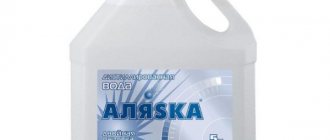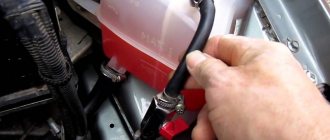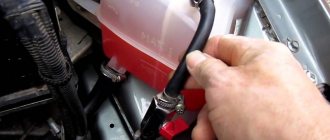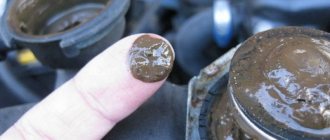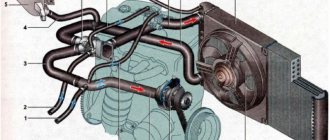When the owner purchases a new car, he has an undeniable advantage, because he can feel and remember how each component or unit works, which is in an unworn condition. After some mileage, the happy owner of a new Lada Kalina already has a clear idea of how a good car should function. Over time, almost all components are subject to natural wear and tear and the first breakdowns begin to occur. This is immediately noticed by the owner, and all his efforts are concentrated on eliminating the defect that has manifested itself.
We remove air from the cooling system on the Lada Kalina
The cooling system ensures proper operation of the radiator-heater and no overheating of the engine. And as long as nothing interferes with the circulation of antifreeze, the owner can be calm.
But as soon as an air lock appears, heating and cooling efficiency drops.
Fortunately, you can deal with this problem on your own.
How to improve SOD?
At the moment, there are several ways to improve ODS:
- Reworking the cooling system. “Kalina” in this case is equipped with a new 6-hole thermostat. This action will make maintaining the temperature of the antifreeze in the system more stable, and will also normalize the operation of the heating elements of the cabin.
- To reduce cooling system malfunctions, the Lada Kalina is equipped with a coolant filter.
- Installation of the stove faucet.
- Additional pump in the engine cooling system. It will not only prevent you from freezing in your car during winter cold, but will also force antifreeze to circulate faster through the channels, which will significantly reduce the risk of engine overheating.
How to get rid of air
There are several ways to remove an air lock from a car's cooling system. Let's consider the first option:
- Set the heater control knob to the maximum value.
- We move under the hood, where it is necessary to remove the decorative cover.
The required connections are marked with arrows.
Second way
The second method is very similar to the first. But in this case you will not have to unscrew the tank cap. All manipulations are carried out in several stages.
- The engine must first be brought to operating temperature, and then turned off.
- Remove the hose from the throttle assembly.
We remove the hose very carefully - the coolant can be hot!
Third way
The third method is the simplest, but also the least effective.
- We install the car so that the level of its front wheels is higher than the rear ones. To do this, you can drive onto an overpass or embankment.
- Remove the plug located on the radiator housing.
- Unscrew the cap of the expansion tank.
The cover is marked with an arrow.
As soon as the level drops below the MIN mark, it is necessary to add antifreeze.
Why does aeration occur?
Water and air are two interconnected elements. When a car malfunctions, they cause a “storm of emotions” in the cooling system. Usually the conflict occurs in a car radiator, which entails a lot of trouble. The first thing motorists notice is that the car is boiling.
This happens while driving, and the temperature outside and the speed of movement do not always affect this process. Engine overheating is associated with malfunctions of the cooling system. This problem requires an immediate solution.
Most modern cars have liquid cooled engines. The radiator in them is the most necessary and mandatory part. Often, a car has two elements installed at once, one is the cooling system, the second is the heating or stove.
For the engine to overheat, the development of one problem out of 3 existing ones is enough. The most common reasons why the system will bleed:
- thermostat jamming;
- lack of coolant;
- airing of the radiator.
It’s easy to check the functionality of the radiator: if the stove on Kalina produces hot air, but the main element is cold, it is necessary to replace the thermostat.
If there is a lack of coolant, the situation becomes more complicated. This problem can be identified by a warm engine. It is necessary to open the radiator cap and check the antifreeze level. If it is small, there is a high probability of leakage, resulting in airing of the system.
How to understand that air has entered the cooling system
If your coolant level drops, air is getting into the system somewhere.
The main sign of a malfunction is a decrease in the efficiency of the stove. gurgling may be heard from under the panel , which indicates a fairly large air lock.
Similar sounds occur when the circulation of antifreeze is disrupted due to airiness in the system.
A plug may also form in the thermostat housing. This is evidenced by the increased engine warm-up time. Because of the air, the thermostat valve is constantly open, and therefore the liquid circulates only in a large cooling circle.
Why does air get into the system?
A malfunction of the valve installed in the expansion tank plug is the most common problem.
There are three main factors that cause air to enter the cooling circuit:
- Inaccurate addition of antifreeze.
- Partial depressurization of the system.
Regardless of the reason, air must be removed from the system, and the sooner this is done, the better.
About design defects of the system
Over time, the owners discovered three significant design flaws in the circulation system of the Lada Kalina engine cooler. They allow air to gradually accumulate inside the circuit, leading to the formation of the well-known plug. When air is present in a sufficiently small volume, the circulation process is only slightly disrupted, which is so far tolerated by the system painlessly. Here, a thermostat is connected as a control element, raising the temperature of the antifreeze (before opening the valve). If you do nothing in this situation, then as air accumulates under the pressure of the plugs, the stove will “give up,” reminding the owner of itself with the previously mentioned “murmuring” and lack of heat supply.
So, the shortcomings:
- The location of the expansion tank is below the upper level of antifreeze in the system.
- Frequent failure of the valve in the tank cap plug.
- Gradual loosening of the clamps holding the pipes at the joints with the circuit elements. Here, over time, there is a danger of not only the plug penetrating into the system while the engine is running, but also creating the risk of fluid leaking out.
Solving the problem of airing the engine cooling system on Lada cars
Have you noticed that the heater in your car is blowing cold air? There may be several reasons for the problem, but most often this occurs due to the formation of an air lock in the engine cooling system. Next, we will tell you how to remove air from the cooling system of Lada cars (Granta, Kalina, Priora, Largus, Niva, Vesta or XRAY) in several ways.
Let us remind you that AVTOVAZ installs the same type of power units on its models, so the instructions are similar for all Lada cars.
Possible malfunctions of the ODS, diagnostics
Almost always, a breakdown of the cooling function of a car is caused by an antifreeze leak. You should inspect the car under the hood for possible leaks. The cause of the leak may be:
- or a leaky clamp;
- or a radiator failure.
Then in the first case the element is replaced; this is not difficult and does not take long. As for the radiator, it is better to have it repaired. There are also no particular difficulties here: often you just need to solder the holes.
The reasons for overheating of this car can also be:
- thermostat. Its suitability is checked using both pipes: the temperature of the latter should not be sharply different (this is determined on a warm engine). Otherwise, the thermostat is faulty and antifreeze circulates in a small circle;
- clogging of radiator honeycombs. You can solve the problem by cleaning the outside of this element. Often this is not always easy to do, but there are no other methods other than manually cleaning the honeycombs;
- Fan malfunction. When the heating level of the coolant increases, this part should begin to operate. If this does not happen, check the relay, wiring or t° sensor;
- air in the coolant system. Lada Kalina is not insured, among other things, against the so-called air lock inside the system. In general, previous types of breakdowns are eliminated quite quickly and almost everything is clear with them. In the latter case, it is necessary to understand in more detail. The question - how to remove air from the Kalina cooling system - is really very important for the optimal functioning of the totality of the elements of this car.
Airlock
If the cooling system becomes airy, you need to do the following: with the expansion tank cap open, start the power unit, squeezing the gas pedal from time to time, warm it up until the t° sensor “reaches” the red scale. After “starting” the ventilation device, “add up the gas” a little more and then you can turn off the ignition.
If the cooling system is still leaking air and the above measures have not led to anything, you should act more radically. What needs to be done to remove air from the cooling system?
First, remove the power motor screen (dismantling is done in an upward direction).
Loosen the clamp with a screwdriver and remove one of the tubes from the heating fitting of the throttle assembly.
Unscrew the cap of the expansion tank. Cover the neck of the opened container with a clean piece of cloth. Now blow into the tank: coolant should flow from the tube that was removed. If you fail to break through the above container, close the lid and place the tube in its place.
Next, warm up the engine again and turn off the ignition. Then the tube must be removed again, without removing the lid from the tank, and wait until the antifreeze flows.
Since this liquid is very poisonous and dangerous for people, drain the coolant with extreme caution. Remember about safety: get rubber gloves
Monitor the temperature of the tubes. Keep in mind that you only need to drain the coolant when the engine has cooled down.
Now the tube is put on the fitting, the clamps are tightened. At this stage, the problem of how to remove air from the cooling system of the car has been successfully solved. As you can see, it is possible to eliminate faults in the ODS without the participation of professionals.
SOD Lada Kalina in a certain sense requires improvement.
At the moment, there are the following methods to improve it:
- rework. The car is equipped with a new thermostat. Thus, the temperature of the antifreeze will become stable, and the activity of the interior heating elements will return to normal;
- to minimize coolant malfunction, the machine is equipped with a coolant filter;
- an additional pump in the above-mentioned power unit system. This will force the antifreeze to circulate through the appropriate channels faster, which will definitely reduce engine overheating. And a plus - in cold weather you will not freeze in the car.
Everything that may be important for a motorist on the above topics regarding the Kalina car: what the Lada Kalina heating system is, as well as airing the cooling system, why the cooling system will air, how to remove air from the cooling system, possible malfunctions, necessary alterations more clearly will tell the presented video.
How to expel air, method No. 1
- Remove the hose from the throttle body heating.
- Open the cap of the expansion tank, cover the neck with a clean rag and blow into the tank.
- When antifreeze starts flowing from the removed tube, quickly put the hose back in place and tighten it with a clamp.
Attention! Coolant is a toxic substance, so we recommend that you use other methods to solve the problem.
How to expel air, with method No. 2
- Warm up the engine until pressure builds up in the engine cooling system.
- Stop the engine and remove the hose from the throttle body heating. We do not open the expansion tank cap.
- As soon as antifreeze runs out of the hose, quickly put it back on and tighten it with a clamp.
Attention! Antifreeze can be very hot, be careful.
Conclusion
As can be seen from the description, the reasons why a malfunction may occur are very diverse. In order to avoid breakdowns, carry out timely vehicle maintenance. In accordance with the manufacturer's instructions, it is recommended to clean all heating elements at least twice a year.
We talked about two ways in which you can fix the problem. Perhaps you know other methods of how to bleed air from the Lada Kalina stove? Share your knowledge and experience with readers in the comments.
Good luck and good luck on the roads!
How to expel air, with method No. 3
- With the engine cooled down, remove the upper hose from the expansion tank coming from the radiator of the cooling system.
- Fill the reservoir to the maximum with coolant and tighten the cap.
- We place the hose in an empty canister, and put a hose from the air pump (for inflating tires) on the tank nozzle.
- We pump up the pressure in the tank with a pump, and at the same time the antifreeze will pour into the canister.
- We monitor the level of coolant in the expansion tank and add it if necessary.
- After 2-3 additions of liquid, we restore all connections.
Principle of operation
The operating algorithm of this system consists in the close interaction of various sensors, parts and elements, including devices that measure oil temperature, outside temperature and many other factors. Taking into account all these points, on the VAZ Kalina the cooling system automatically sets the optimal switching conditions and operating time of all structural elements, thereby ensuring effective engine cooling.
It should also be noted that depending on the temperature, the liquid can pass through a small or large circle. In the first case, the antifreeze passes through all the channels of the system, bypassing the radiator. The thermostat is in the closed position during such circulation. When the engine temperature increases, this part gradually opens, and the antifreeze begins to “run” in a large circle, getting into the radiator. The latter is cooled by a counter flow of air, and if the SOD is not enough, it will send a signal to the fan, which will force cold air onto the cells.
After cooling, the coolant flows back to the small circle. Then, depending on the engine temperature, the system automatically circulates antifreeze either in a large or small circle, maintaining the optimal operating temperature of the internal combustion engine (95-105 degrees Celsius).
Refinement of SOD from airing
Owners of LADA Kalina (1.6l, 8kl) cars are offering a simple modification that will solve the problem of constant airing of the engine cooling system. If the antifreeze leaves, then you should look for a leak. If the antifreeze stands still and an air lock appears periodically, you should extend the hose from the radiator so that its end is immersed in the coolant in the expansion tank:
If this modification does not help and airing of the cooling system occurs periodically, then the car’s cooling system is not sealed. Check the connections of all system hoses for leaks, as well as the expansion tank cap.
Source
Functional range of elements of a car cooling system
The standard cooling system consists of the following elements:
- sensors – determine t° in certain auto mechanisms; one of the management elements of the system;
- pump – makes it possible to circulate liquid in the SOD; operates in a forced mode;
- pipes – coolant moves through them;
- expansion tank - compensates for the volume of antifreeze, since due to temperature fluctuations it narrows and expands;
- radiator - a device that discharges excess heat into the environment;
- fan – activates the cooling process by forcing air; With its help, the cooling intensity increases;
- Thermostat - although small, is a very important element that regulates the amount of antifreeze; provides a “comfortable” temperature regime throughout the entire system.
Operating principle
The cooling system operates in a self-regulating mode, which is aimed at maintaining optimal temperature in the power unit. If the oil temperature rises significantly, the system does everything to ensure that the temperature inside the engine decreases.
Thus, with the close interaction of the above elements, the system functions. It automatically sets the necessary conditions for the inclusion and operation of structural parts, which ensures effective cooling of the power unit.
And if any problems arise with the functionality of the components of this system, it is necessary to carefully examine the safety of its main components. If the driver is qualified and experienced enough, he can cope with the task independently. Otherwise, it is better for an owner who is not very knowledgeable about cars to seek help from a service station.
How to vent the cooling system of a Lada Kalina 8 valves
- To the beginning of the forum
- Forum Rules
- Old design
- FAQ
- Search
- Users
Over the weekend I changed the stove using the official method (you can applaud while sitting) and now I can’t get the plug out of the system.
Symptoms: gurgles when gasping when cold; quickly overheats under load after prolonged engine braking (3 minutes from a big mountain), but Carlson copes with a bang; the stove blows either lukewarm or completely cold (especially when overheating begins); and until you brake the engine thoroughly, the temperature stays at 85-88, and then after it cools down from braking, overheating begins.
He was gasping uphill with his muzzle, blowing into the tank with the hose removed from the remote control.
The thermostat was changed shortly before the stove and worked fine. The main radiator is also new. That is, except for the pump and two pipes, everything is new.
blowing into the tank with the hose removed from the remote control
Anyway, hang up. It looks like the new thermostat has failed. The little goat lasted only three weeks. I barely made it home - I worsened two traffic jams while I was cooling down on the emergency gang. And it heated up so much that even a long piiiiiiiiii sound was heard (the last white division). The air coming out of the stove is icy. The bottom pipe is also cold.
And in what position do you think it got stuck?
In superposition, lol. I honestly don't know. It seems to me that the thermostat was jammed, and there was a plug there too. The level in the tank is at the top mark.
Be that as it may, this morning I dropped it off for a replacement thermostat, but now I’ve already picked it up and got to work normally. Let's see what happens next.
In superposition, lol. I honestly don't know. It seems to me that the thermostat was jammed, and there was a plug there too. The level in the tank is at the top mark.
Be that as it may, this morning I dropped it off for a replacement thermostat, but now I’ve already picked it up and got to work normally. Let's see what happens next.
Did you pick up your working thermostat from the servicemen?
Took away. The serviceman has been his own since the time when I didn’t even have a car.
But! No, not like that. BUT.
I arrived from work already wearing a tie. The symptoms are the same - an icy stove and a hellishly hot engine. Instead of torturing me like yesterday, I called a friend to carry me home. Therefore, something terrible happened - the cylinder head gasket blew. Why I got to work without any problems after stopping all the traffic lights and driving uphill remains a mystery. In the meantime, I’ll go and pay with the money - we’ll have to part ways soon.
So, with the frosts, I not only changed the entire cooling system (I also changed the radiator), but also had to undergo serious repairs to the dryer. But the six months after the ancient 99 were only pleasing.
Question: Can I get 1 km to the service station on my own or can I do much worse?
Something is too scary a story. Last winter (the first winter of my viburnum) I also had an air lock, the pipes were leaking, more than half a liter of antifreeze escaped - through these loose pipes I grabbed air, so much so that it’s just like here - it’s cold from the stove, the engine temperature is rising, the pump consider nothing is driving. It's useless to overheat - you'll overheat. I expelled the air through the jumper going to the throttle heating (I have e-gas), tightened the pipes, added antifreeze - and that’s it! no problems, the plug, even if it partially remained, came out on its own, I never accelerated with the hood up. Then I really tried to make all sorts of modifications to the SOD, so that the traffic jam would definitely be expelled, but later I removed all the modifications, they were of no use, I returned everything as it was. The only thing I added was a spool valve for releasing air on the jumper to the throttle assembly, but I never used it this winter - there was no plug. I drive every day, and in cold weather, there is no air lock. The pipes don’t flow, they apparently died down last time.
Therefore, IMHO, my friend’s problem is that after replacing everything in a row, the pipes sit poorly in the SOD and air is sucked out of these cracks, and then gradually, and the freezing RB plug aggravates this. If you unscrew the plug after a trip, the system will not get enough air, it has been checked, but this is a temporary test. Or there are cracks in new radiators, etc.
Short story:
With a flashlight we saw antifreeze in the fourth cylinder.
A long story for the edification of those who Google:
I looked at the cold spark plugs and oil - everything was clean. I unscrewed the tank cap and there was still a little pressure there. Warmed up to 90 idle. The stove became a little warm. The exhaust is normal. The temperature went over 90 - the stove became icy. Turned it off at 100 degrees. I released the pressure from the tank (pshshch - gurg - glug - all over the entire hood). I pumped it using the “mouth in RB - antifreeze with remote control” method. Started it again - no problem. I drove around the area - everything was ok. I stopped, cooled it down to 70. Started it again and drove off - it overheated. I released the pressure again. I found out that the stove heats up to Tashkent only if you turn on the gas. The car warmed up less when accelerating, which is why the pump came under suspicion. This was followed by several more cycles of warming up, cooling down and releasing pressure in different orders and with different results. That is a dead end. Finally decided to measure the compression. However, the compression gauge turned out to be broken. But smoke was noticed from the fourth cylinder. I looked there with a flashlight and saw green. Diagnosis: cylinder head gasket failure. Moreover, the breakdown is small, insufficient for a white exhaust. The car is sent for repair. Thank you for your attention.
Source
How to remove an air lock from the Lada Kalina cooling system
A sealed cooling system ensures that the heater will work properly and the engine will not overheat, since the antifreeze circulates stably. However, as soon as an air lock appears, the efficiency of the cooling and heating system comes to an end. We’ll figure out how to remove an air lock from the cooling system of the Lada Kalina right now.
Spoilers
One of the favorite pastimes of novice tuners is to install spoilers in all possible places. Of course, a spoiler is a very useful thing. But getting carried away beyond measure (especially for cars like the Lada Kalina) is not recommended. We remember that this is still not a racing car. We will limit ourselves to the front spoiler, which looks harmonious and fulfills its aerodynamic functions. Gluing it is quite simple and inexpensive.
Wheels:
External transformations include replacing factory wheels with alloy ones, and standard tires with lowered ones. Some lovers of night walks also use LED illumination of the rims and underbody, achieving a truly cosmic effect. Decide for yourself: do you need this?
Signs of an air lock in the Kalina cooling system
The cooling system in all modern engines must be as tight as possible. Old engines did not have an expansion tank and the coolant was poured directly into the top can of the radiator. This was due to low requirements for the quality and composition of antifreeze, as well as unpretentious materials from which cylinder blocks, heads and other cooled engine elements were made.
Lada Kalina cooling system diagram
Be that as it may, in a sealed cooling system, the slightest amount of air can cause a disruption in the circulation of antifreeze and, as a result, overheating of the engine, boiling of the liquid and disruption of the heater. In short, if we notice that:
the engine overheats under light loads and the ambient temperature is not too high;
the stove does not blow hot air, but slightly warm air, even when the engine temperature gauge is in the red zone;
The heater radiator is leaking, there are other places where antifreeze is leaking,
you can be sure that a plug has formed in the cooling system. At the same time, we are confident that all components of the cooling system work like clockwork. Namely, the water pump, thermostat, heater radiator and cooling radiator, nothing leaks anywhere.
Technical features of the system
Expansion tank
The unified layout and closed design of the engine cooling system (SOD) of the Kalina are also characteristic of other VAZ models. The system is designed to remove thermal energy from heated engine elements using antifreeze or other coolant.
The SOD consists of the following functional parts.
- Cooling radiator. Reduces coolant temperature due to the flow of cold air masses.
- Fan. Used for rapid cooling of antifreeze in the Kalina cooling system.
- Expansion tank. Designed to compensate for the volume of coolant (coolant). The need for this unit is related to the expansion/constriction property of the coolant.
- A pump or centrifugal pump, which is responsible for the forced circulation of antifreeze through the appropriate channels.
- A thermostat whose task is to regulate the volume of antifreeze in the Kalina cooling system.
- Temperature sensor involved in SOD control.
The operation of the cooling system is based on the close interconnection of various parts, elements and sensors, including devices that are designed to measure oil temperature. The passage of coolant in a large or small circle depends on the engine temperature. In the first case, antifreeze passes through all components of the SOD, except the radiator. With such circulation, the thermostat is closed. As the engine temperature rises, this element gradually opens. The antifreeze, having passed a large circle, enters the radiator. The latter device is cooled by oncoming air masses. If this is not enough, a signal is sent to the ventilated unit, which begins to forcibly direct air masses to the cells.
The cooled liquid enters a small circle. Next, taking into account the engine temperature, the antifreeze automatically circulates in a small or large circle. At the same time, the optimal operating temperature is maintained, which should be in the range of 95-105°C. This factor has a direct impact on the performance of the Kalina stove. In this case, it will not be able to supply warm air masses into the cabin.
https://youtube.com/watch?v=qX3qBD0IXFI
If there are any doubts about the operation of the ODS, you need to diagnose the car, finding out the causes of the malfunction. You can fix the breakdown either with your own hands or with the help of a car mechanic.
First, it is recommended to check the antifreeze level in the system. To do this, you will need to open the hood and inspect the expansion tank. It should be filled to 1/2 of the total volume. If necessary, antifreeze is topped up or the coolant is completely replaced. In the latter case, you will need to drain the old antifreeze. If there is a fluid leak, you need to inspect the engine compartment.
Where did the air lock come from in the radiator of the Lada Kalina stove?
Any leak in the system or improper replacement of the coolant can easily lead to the formation of an air lock in the radiators, pipes or in the water jacket. Airing of the cooling system occurs as follows - when antifreeze leaks from the pipe or radiator, air is slowly sucked in and occupies the free volume in the system. This does not happen immediately, but when enough air bubbles have accumulated, the cork is ready for use. Typically, air collects at the highest point of the cooling system. On Kalina this is the throttle assembly heating system.
In addition, air can easily form due to the use of low-quality antifreeze. This is explained simply - good liquids boil extremely rarely, for this they need to be heated to at least 140-160 ˚С, which is almost impossible. Low-quality antifreezes and everyone’s favorite antifreeze can boil already at a temperature of about 100 ° C, and this, as we know, is almost the operating temperature of the Kalina engine. When boiling, like any liquid, antifreeze releases air bubbles, which again accumulate and form a plug that prevents circulation.
Any leakage leads to an air lock.
And one more, most unpleasant moment. It is not air that may enter the cooling system, but exhaust gases. This indicates that the head gasket has given up its life and has burned out, gases have broken into the cooling system and formed a plug. In this case, there is only one treatment - replacing the cylinder head gasket and finding out the causes of the burnout.
The stove blows cold at low speeds: causes and solutions.
We always say that everything in a car is interconnected, therefore, if one of its elements breaks down, the source of the problem must be looked for in everything that is directly or indirectly connected with this element. The cooling system is no exception. It can produce cold air at idle under the following circumstances:
there is too little coolant in the expansion tank;
This is perhaps the most common option. Agree, even though we know that the amount of antifreeze in the system needs to be checked before each trip, we don’t always do this. As a result, the coolant level may become critically low, that is, insufficient to cope with its functions at low speeds.
What to do: check the coolant level in the expansion tank and, if necessary, top up to the required level.
air pockets have formed somewhere;
In cases where work has recently taken place that requires replacing or partially draining the antifreeze, the reason that the heater is blowing cool may be air pockets formed inside the tubes, which simply do not allow the coolant to circulate normally.
What to do: put the front of the car on a hill, unscrew the cap from the expansion tank, start the car and wait until it warms up - you will notice bubbles appearing as soon as they pass - turn off the car, wait until it cools down a little (so as not to get burned) and return the cap to place.
pump is faulty;
Another problem that may cause warm antifreeze to not reach the heater is a faulty water pump.
What to do: detecting this problem is often quite simple by the characteristic knocking and rumble. If you haven’t noticed one, watch your vehicle; if it gets very hot, even to the point of boiling, remove the pump and disassemble it. If the impeller lives its own life or does not spin at all, replace it or the entire water pump.
radiator tubes are clogged
A very common option, along with an insufficient level of coolant: salts and dirt gradually accumulate on the walls of the tubes supplying coolant to the radiator during operation, and over time there are so many of them that hot liquid cannot even pass through them. As a result, the radiator remains cold, as does the air passing through it.
What to do:
Option 1: Flush the system. To do this, drain the coolant present in it, and in its place, fill in a special cleaning composition or a concentrated solution of citric acid. Start the engine and let it warm up to operating temperature. Drain the cleaning solution and add fresh coolant.
Option 2 (usually used only if the previous method was ineffective). Replace the tubes and radiator.
coolant supply is cut off;
Almost every modern car is equipped with a tap that allows you to shut off the supply of antifreeze to the heater. It allows you to avoid the risk of overheating the interior in the warm season, but at the same time, being a weak point of the heating system, it can create additional troubles.
What to do: check the position of the tap and open it if necessary. If the faucet is jammed, it must be replaced.
A little advice: if you own a VAZ car, we advise you to pay a little extra and purchase a faucet not of domestic production, but of the Audi brand - with it you will not have to replace it every six months.
low coolant temperature;
The last situation in which the heater can give off cold is cold antifreeze. And it can be like this in two cases:
- it's too cold outside, so on short trips the engine simply doesn't have time to warm up
What to do: insulate the engine compartment.
- The thermostat has broken down - it is stuck in the open position, as a result of which the coolant “drives” in a large circle, not allowing it to warm up properly.
What to do: check and, if necessary, replace the failed part.
